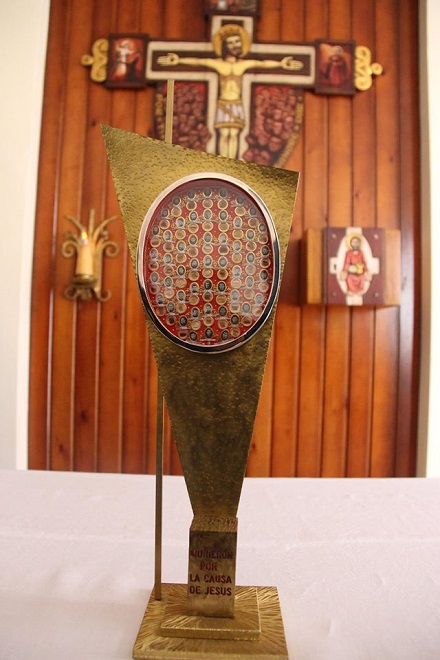RELICS
DEFINITION
Bodily remains, objects of use, products or traces of persons of religious importance, or attributed to them, kept in sacred places and venerated in worship; in particular, in the Christian tradition, the mortal remains of the body (or the blood kept in ampoules) of martyrs of the faith, the instruments of their martyrdom, or even the body of a saint.
DEVOTION
The cult of relics began as a memory and veneration of a martyr’s tomb. A few centuries later, the bones of holy monks began to be venerated as well, as a gesture of affection towards the fathers. Through the veneration of what was left of their passage on earth, the veneration of their lives, their example, and a mysterious communion with them was manifested. According to a “rationalist” view, the veneration of relics is an archaic behavior, which has led to absurdities. Centers of pilgrimage have fought over relics, created relics, traded relics, etc. Man, crushed by his condition, by the fear of suffering and death, takes refuge in magical behaviors, which protect him and allow him to survive. Science today sheds light on all these attitudes. Many “extraordinary” phenomena occurred in the past have found scientific explanation and those who do not find it today, will find it tomorrow. The opposite attitude is the magical one, absent of any critical spirit: relics are a kind of “talisman” that protects; the supernatural is seen as a radioactive force that, without being seen, acts. One must perform a certain number of acts, and the result will follow. The medals, the reliquary, the prayers are the obligatory condition. To tell the truth, the concrete history of our “saints” is very far from this. It is clear that we must avoid misunderstandings and exaggerations, and lead back to the right devotion, but according to the doctrine of the Catholic Church, acts of devotion are not assimilable to magical or superstitious practices because while those who practice the latter believe that they have efficacy for themselves; in the case of relics, instead, it is not the act in itself that has efficacy, but the prayer that accompanies it, and even this only insofar as the grace requested is granted by the free choice of God. We invoke the saints so that they in turn intervene with the Lord, always the ultimate goal of prayer. To venerate a relic is to venerate the mercy of God realized in the saint. To pray before the body of a saint is to thank God who has sustained him or her on the path of holiness.
NORMS
“The honor accorded to sacred images is a ‘respectful veneration,’ not an adoration befitting only God. Acts of worship are not directed to the images considered in themselves, but insofar as they serve to depict the incarnate God. Now, the motion that turns to the image as an image, does not stop on it, but rather tends to the reality it represents.”
(Catechism of the Catholic Church, 2131-2132)
“Relics point us to God himself: it is he who, by the power of his grace, grants fragile beings the courage to bear witness to him before the world. In inviting us to venerate the mortal remains of martyrs and saints, the Church does not forget that, in the final analysis, these are poor human bones, but bones that belonged to persons visited by the living Power of God. The relics of the saints are traces of that invisible but real presence which illuminates the darkness of the world, manifesting the Kingdom of Heaven which is within us.”
(Benedict XVI, Address to Young People at World Youth Day, Cologne, August 18, 2005)
RELIC REQUEST
The General Postulation is responsible for the custody and distribution of the relics of the Blessed and Saints belonging to the Congregation. In order to request relics, the following norms must be taken into account:
1. It is the responsibility of the General Postulation to evaluate the requests received and to grant the relics, accompanied by the certificate of authenticity, bearing the seal of the same Postulation.
2. Each request must arrive at the office of the General Postulation by letter with letterhead, with the signature of the responsible official and stamp of the office. For 1st degree relics, the request must be accompanied by the original nihil obstat of the local Ordinary or Major Religious Superior; requests by telephone or fax will not be considered.
3. As a rule, only requests from parish priests or superiors of religious communities will be accepted. It must always be specified that the request of the relics is for the public veneration of the faithful; it must be clearly indicated the place of the church or public chapel where the relic will be placed for the veneration of the faithful.
4. Requests from the laity (including seminarians) are not considered except in exceptional cases. Requests from relic collectors are not considered. Only a relic of a particular saint or blessed is granted.
5. Requests are granted for places where there is already a cult or where there is a desire to increase devotion (e.g., by means of an educational catechetical program; on the occasion of the display of a new image of the saint or blessed, a pilgrimage, etc.).
For the consecration of relics of a particular saint or blessed.
For the consecration of altars, requests can be made for “distinguished” relics that the Postulation will consider on a case-by-case basis. The request must always be accompanied by the nihil obstat of the Ordinary of the place or Major Religious Superior, specifying for which church the request is made.
To request relics, it is necessary to have the nihil obstat of the Ordinary of the place or Major Religious Superior.
To request relics fill out the module found at this link.
The relic, should the request be accepted, will be sent or delivered personally, only after the original of the letter from the bishop or religious major superior is received by the office of the General Postulation.
The address is as follows:
General Postulation
Missionari Clarettiani,
Via Sacro Cuore di Maria, 5
00197 Roma
ITALIA



